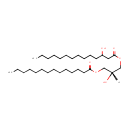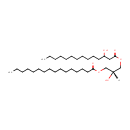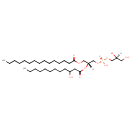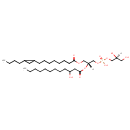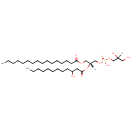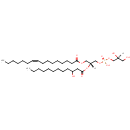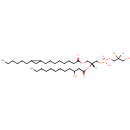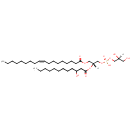
Search Results for compounds
Searching compounds for
returned 4373 results.
Displaying compounds 2211 - 2220 of
4373 in total
DG(14:0(3-OH)/14:0/0:0) (PAMDB006887)
IUPAC:
(2R)-2-hydroxy-3-(tetradecanoyloxy)propyl 3-hydroxytetradecanoate
CAS: Not Available
Description: DG(14:0(3-OH)/14:0/0:0) belongs to the family of Diacylglycerols. These are glycerolipids lipids containing a common glycerol backbone to which at least one fatty acyl group is esterified. DG(14:0(3-OH)/14:0/0:0) is also a substrate of diacylglycerol kinase. It is involved in the phospholipid metabolic pathway.
DG(14:0(3-OH)/16:0/0:0) (PAMDB006888)
IUPAC:
(2R)-2-hydroxy-3-[(3-hydroxytetradecanoyl)oxy]propyl hexadecanoate
CAS: Not Available
Description: DG(14:0(3-OH)/16:0/0:0) belongs to the family of Diacylglycerols. These are glycerolipids lipids containing a common glycerol backbone to which at least one fatty acyl group is esterified. DG(14:0(3-OH)/16:0/0:0) is also a substrate of diacylglycerol kinase. It is involved in the phospholipid metabolic pathway.
DG(14:0(3-OH)/16:1(9Z)/0:0) (PAMDB006889)
IUPAC:
(2R)-2-hydroxy-3-[(3-hydroxytetradecanoyl)oxy]propyl (9Z)-hexadec-9-enoate
CAS: Not Available
Description: DG(14:0(3-OH)/16:1(9Z)/0:0) belongs to the family of Diacylglycerols. These are glycerolipids lipids containing a common glycerol backbone to which at least one fatty acyl group is esterified. DG(14:0(3-OH)/16:1(9Z)/0:0) is also a substrate of diacylglycerol kinase. It is involved in the phospholipid metabolic pathway.
PG(12:0(3-OH)/14:0(3-OH)) (PAMDB004044)
IUPAC:
[(2S)-2,3-dihydroxypropoxy][(2R)-2-[(3-hydroxydodecanoyl)oxy]-3-[(3-hydroxytetradecanoyl)oxy]propoxy]phosphinic acid
CAS: Not Available
Description: PG(12:0(3-OH)/14:0(3-OH)) is a phosphatidylglycerol. Phosphatidylglycerols consist of a glycerol 3-phosphate backbone esterified to either saturated or unsaturated fatty acids on carbons 1 and 2. As is the case with diacylglycerols, phosphatidylglycerols can have many different combinations of fatty acids of varying lengths and saturation attached to the C-1 and C-2 positions. PG(12:0(3-OH)/14:0(3-OH)), in particular, consists of one 3-hydroxydodecanoyl chain to the C-1 atom, and one 3-hydroxytetradecanoyl to the C-2 atom. In Pseudomonas aeruginosa glycerophospholipid metabolism, phosphatidylglycerol is formed from phosphatidic acid (1,2-diacyl-sn-glycerol 3-phosphate) by a sequence of enzymatic reactions that proceeds via two intermediates, cytidine diphosphate diacylglycerol (CDP-diacylglycerol) and phosphatidylglycerophosphate (PGP, a phosphorylated phosphatidylglycerol). Phosphatidylglycerols, along with CDP-diacylglycerol, also serve as precursor molecules for the synthesis of cardiolipin, a phospholipid found in membranes.
PG(12:0(3-OH)/15:0) (PAMDB004045)
IUPAC:
[(2S)-2,3-dihydroxypropoxy][(2R)-2-[(3-hydroxydodecanoyl)oxy]-3-(pentadecanoyloxy)propoxy]phosphinic acid
CAS: Not Available
Description: PG(12:0(3-OH)/15:0) is a phosphatidylglycerol. Phosphatidylglycerols consist of a glycerol 3-phosphate backbone esterified to either saturated or unsaturated fatty acids on carbons 1 and 2. As is the case with diacylglycerols, phosphatidylglycerols can have many different combinations of fatty acids of varying lengths and saturation attached to the C-1 and C-2 positions. PG(12:0(3-OH)/15:0), in particular, consists of one 3-hydroxydodecanoyl chain to the C-1 atom, and one pentadecanoyl to the C-2 atom. In Pseudomonas aeruginosa glycerophospholipid metabolism, phosphatidylglycerol is formed from phosphatidic acid (1,2-diacyl-sn-glycerol 3-phosphate) by a sequence of enzymatic reactions that proceeds via two intermediates, cytidine diphosphate diacylglycerol (CDP-diacylglycerol) and phosphatidylglycerophosphate (PGP, a phosphorylated phosphatidylglycerol). Phosphatidylglycerols, along with CDP-diacylglycerol, also serve as precursor molecules for the synthesis of cardiolipin, a phospholipid found in membranes.
PG(12:0(3-OH)/15:0cyclo) (PAMDB004046)
IUPAC:
[(2R)-3-{[8-(2-butylcyclopropyl)octanoyl]oxy}-2-[(3-hydroxydodecanoyl)oxy]propoxy][(2S)-2,3-dihydroxypropoxy]phosphinic acid
CAS: Not Available
Description: PG(12:0(3-OH)/15:0cyclo) is a phosphatidylglycerol. Phosphatidylglycerols consist of a glycerol 3-phosphate backbone esterified to either saturated or unsaturated fatty acids on carbons 1 and 2. As is the case with diacylglycerols, phosphatidylglycerols can have many different combinations of fatty acids of varying lengths and saturation attached to the C-1 and C-2 positions. PG(12:0(3-OH)/15:0cyclo), in particular, consists of one 3-hydroxydodecanoyl chain to the C-1 atom, and one cis-9,10-Methylenetetradecanoic acid to the C-2 atom. In Pseudomonas aeruginosa glycerophospholipid metabolism, phosphatidylglycerol is formed from phosphatidic acid (1,2-diacyl-sn-glycerol 3-phosphate) by a sequence of enzymatic reactions that proceeds via two intermediates, cytidine diphosphate diacylglycerol (CDP-diacylglycerol) and phosphatidylglycerophosphate (PGP, a phosphorylated phosphatidylglycerol). Phosphatidylglycerols, along with CDP-diacylglycerol, also serve as precursor molecules for the synthesis of cardiolipin, a phospholipid found in membranes.
PG(12:0(3-OH)/16:0) (PAMDB004047)
IUPAC:
[(2S)-2,3-dihydroxypropoxy][(2R)-3-(hexadecanoyloxy)-2-[(3-hydroxydodecanoyl)oxy]propoxy]phosphinic acid
CAS: Not Available
Description: PG(12:0(3-OH)/16:0) is a phosphatidylglycerol. Phosphatidylglycerols consist of a glycerol 3-phosphate backbone esterified to either saturated or unsaturated fatty acids on carbons 1 and 2. As is the case with diacylglycerols, phosphatidylglycerols can have many different combinations of fatty acids of varying lengths and saturation attached to the C-1 and C-2 positions. PG(12:0(3-OH)/16:0), in particular, consists of one 3-hydroxydodecanoyl chain to the C-1 atom, and one hexadecanoyl to the C-2 atom. In Pseudomonas aeruginosa glycerophospholipid metabolism, phosphatidylglycerol is formed from phosphatidic acid (1,2-diacyl-sn-glycerol 3-phosphate) by a sequence of enzymatic reactions that proceeds via two intermediates, cytidine diphosphate diacylglycerol (CDP-diacylglycerol) and phosphatidylglycerophosphate (PGP, a phosphorylated phosphatidylglycerol). Phosphatidylglycerols, along with CDP-diacylglycerol, also serve as precursor molecules for the synthesis of cardiolipin, a phospholipid found in membranes.
PG(12:0(3-OH)/16:1(9Z)) (PAMDB004048)
IUPAC:
[(2S)-2,3-dihydroxypropoxy][(2R)-3-[(9Z)-hexadec-9-enoyloxy]-2-[(3-hydroxydodecanoyl)oxy]propoxy]phosphinic acid
CAS: Not Available
Description: PG(12:0(3-OH)/16:1(9Z)) is a phosphatidylglycerol. Phosphatidylglycerols consist of a glycerol 3-phosphate backbone esterified to either saturated or unsaturated fatty acids on carbons 1 and 2. As is the case with diacylglycerols, phosphatidylglycerols can have many different combinations of fatty acids of varying lengths and saturation attached to the C-1 and C-2 positions. PG(12:0(3-OH)/16:1(9Z)), in particular, consists of one 3-hydroxydodecanoyl chain to the C-1 atom, and one 9Z-hexadecenoyl to the C-2 atom. In Pseudomonas aeruginosa glycerophospholipid metabolism, phosphatidylglycerol is formed from phosphatidic acid (1,2-diacyl-sn-glycerol 3-phosphate) by a sequence of enzymatic reactions that proceeds via two intermediates, cytidine diphosphate diacylglycerol (CDP-diacylglycerol) and phosphatidylglycerophosphate (PGP, a phosphorylated phosphatidylglycerol). Phosphatidylglycerols, along with CDP-diacylglycerol, also serve as precursor molecules for the synthesis of cardiolipin, a phospholipid found in membranes.
PG(12:0(3-OH)/17:0cycw7c) (PAMDB004049)
IUPAC:
[(2S)-2,3-dihydroxypropoxy][(2R)-3-{[8-(2-hexylcyclopropyl)octanoyl]oxy}-2-[(3-hydroxydodecanoyl)oxy]propoxy]phosphinic acid
CAS: Not Available
Description: PG(12:0(3-OH)/17:0cycw7c) is a phosphatidylglycerol. Phosphatidylglycerols consist of a glycerol 3-phosphate backbone esterified to either saturated or unsaturated fatty acids on carbons 1 and 2. As is the case with diacylglycerols, phosphatidylglycerols can have many different combinations of fatty acids of varying lengths and saturation attached to the C-1 and C-2 positions. PG(12:0(3-OH)/17:0cycw7c), in particular, consists of one 3-hydroxydodecanoyl chain to the C-1 atom, and one heptadec-9-10-cyclo-anoyl to the C-2 atom. In Pseudomonas aeruginosa glycerophospholipid metabolism, phosphatidylglycerol is formed from phosphatidic acid (1,2-diacyl-sn-glycerol 3-phosphate) by a sequence of enzymatic reactions that proceeds via two intermediates, cytidine diphosphate diacylglycerol (CDP-diacylglycerol) and phosphatidylglycerophosphate (PGP, a phosphorylated phosphatidylglycerol). Phosphatidylglycerols, along with CDP-diacylglycerol, also serve as precursor molecules for the synthesis of cardiolipin, a phospholipid found in membranes.
PG(12:0(3-OH)/18:1(9Z)) (PAMDB004050)
IUPAC:
[(2S)-2,3-dihydroxypropoxy][(2R)-2-[(3-hydroxydodecanoyl)oxy]-3-[(9Z)-octadec-9-enoyloxy]propoxy]phosphinic acid
CAS: Not Available
Description: PG(12:0(3-OH)/18:1(9Z)) is a phosphatidylglycerol. Phosphatidylglycerols consist of a glycerol 3-phosphate backbone esterified to either saturated or unsaturated fatty acids on carbons 1 and 2. As is the case with diacylglycerols, phosphatidylglycerols can have many different combinations of fatty acids of varying lengths and saturation attached to the C-1 and C-2 positions. PG(12:0(3-OH)/18:1(9Z)), in particular, consists of one 3-hydroxydodecanoyl chain to the C-1 atom, and one 9Z-octadecenoyl to the C-2 atom. In Pseudomonas aeruginosa glycerophospholipid metabolism, phosphatidylglycerol is formed from phosphatidic acid (1,2-diacyl-sn-glycerol 3-phosphate) by a sequence of enzymatic reactions that proceeds via two intermediates, cytidine diphosphate diacylglycerol (CDP-diacylglycerol) and phosphatidylglycerophosphate (PGP, a phosphorylated phosphatidylglycerol). Phosphatidylglycerols, along with CDP-diacylglycerol, also serve as precursor molecules for the synthesis of cardiolipin, a phospholipid found in membranes.
